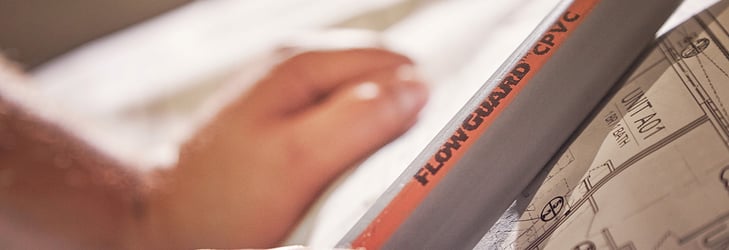Plastic water pipe bacteria - CPVC vs PPR
What makes a plumbing pipe potentially dangerous? How do we fight off harmful bacteria at home, in the places we can't reach?
Bacteria exists all around us; it's everyone's responsibility to keep it under control.
The inner surfaces of our plumbing pipes are hard to reach areas that we rely on every day, to provide us with safe, clean water. FlowGuard® CPVC is designed to do exactly that, reducing the invisible threat of harmful bacteria causing stress on modern homes.
Which plumbing pipe is best?
In recent blogs, we have discussed the biofilm potential in polypropylene material (PPR) and chlorinated polyvinyl chloride (CPVC.)
Let's take a closer look at the material properties of polypropylene material and CPVC, to understand why bacteria reacts so differently to plumbing materials and why, most importantly, we need to decide the best way to protect our homes.
CPVC vs PPR - mechanical properties

The varying strength and overall toughness between these two pipe materials is a key difference maker in the assessment of biofilm potential.
PPR Pipe consists predominantly of organic materials, therefore it is a more natural environment for bacteria to establish a safe presence, sometimes very quickly, presenting a potential threat to water safety much sooner.
CPVC is specifically designed with an exceptionally high level of chlorine, boosting plumbing pipe's tensile strength and toughness. More importantly to bacteria, it gives pipes their superior smoothness, preventing bacteria from establishing a strong presence.
FlowGuard CPVC contains more chlorine than CPVC alternatives; its trademark pipe smoothness is one of the main defences against bacterial growth.
CPVC vs PPR - additives

In order for PPR to possess the required qualities to be considered suitable for water distribution, it depends on the use of many additives, such as plasticisers.
While these resources boost the qualities of PPR, some plasticisers act as a natural source of nutrients for fungi, giving potentially harmful bacteria sustenance to aid in its growth within pipes.
CPVC does not require additional plasticisers to provide water distribution as plumbing pipes.
FlowGuard CPVC and its contained additives do not assist the survival of biofilm and associated bacteria, in any way.
CPVC vs PPR - chemical resistance

Arguably the biggest threat to water pipes' suitability to resist bacteria, is in its chemical resistance. The chemicals contained within our natural water supply can make a huge difference to the plastic material that passes through daily.
PPR is naturally weak against chlorine and chlorine dioxide, both of which are used in the majority of water supplies around the world to help keep the water supplies safe.
When PPR material degrades under these conditions, it creates uneven surfaces, upon which biofilm can attach and thrive.
CPVC is made predominantly from chlorine and is therefore immune to this common additive. Its inherent immunity to chlorinated water helps maintain its recognised pipe smoothness.
FlowGuard CPVC's inherent chemical resistance protects households from bacteria throughout its designed service life of 50 years.
CPVC vs PPR - structural material properties

When PPR pipes and fittings are installed, heat fusion creates internal beading. Not only does this create performance issues (with regards to water flow and pressure,) but the uneven surfaces and crevices created by beading can host concentrated levels of bacteria in certain areas.
This affects overall performance quality and threatens the cleanliness of the water supply.
CPVC pipes and fittings are installed using solvent cement. This cold installation process does not require heat and does not create internal beading.
The molecular fusion of pipe to fitting creates what is essentially one continuous run of pipe, with no beading, bumps or crevices for bacteria to hide within.
FlowGuard CPVC piping joints become the strongest part of the system and do not help accommodate bacterial growth, even in the most complicated installations.
Learn more
The threat of waterborne bacteria and its associated diseases is one of the main reasons FlowGuard CPVC is committed to improving our understanding of water safety.
To learn more about the impact of pipe material on home water supplies, and what to look for when specifying pipe material for your home, download the Homeowner's Guide to CPVC.
.png)
-1.png)